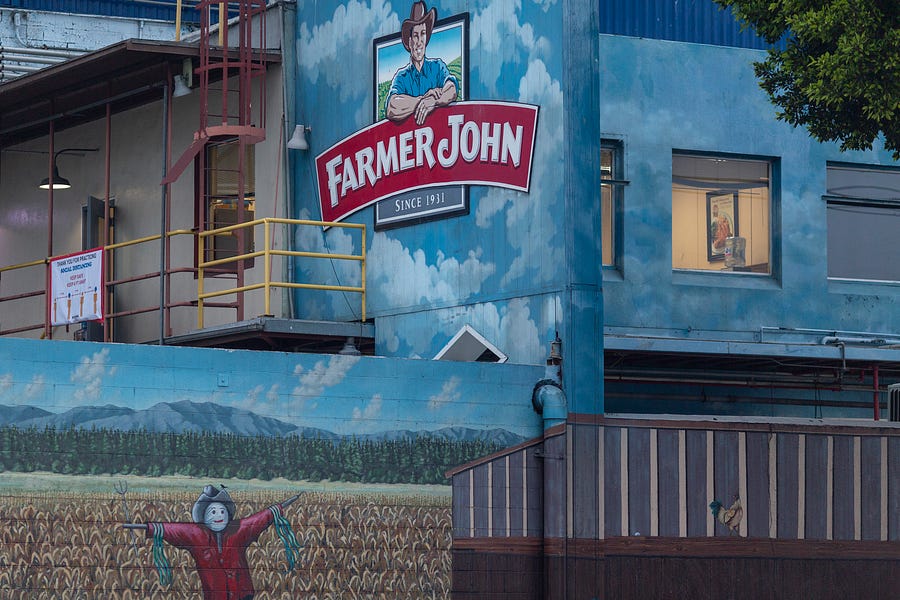On March 25, 2020, 502,842 hogs were slaughtered in the United States, an all-time record. If you live where I do, hog slaughter numbers are big news. Really. The local farm report tracks this number on the radio every morning, along with high school golf scores and the weather report. I’ve never told anybody from either coast that people in the Midwest follow hog slaughter reports. (Such is the inferiority complex that comes with being a Midwesterner.)
On April 29, 267,000 hogs were killed in the United States in processing plants. That number was national news. COVID-19 had devastated the workforce in a number of U.S. processing facilities, not only sickening thousands of workers—many recent immigrants to the U.S.—but also disrupting beef and pork supplies for American consumers. By late April, infected workers at one large pork plant in South Dakota accounted for fully one-third of the reported cases of coronavirus in the state. The second-largest pork processing plant in the U.S., in St. Joseph, Missouri, (about 60 miles from my farm) had nearly 400 cases, most asymptomatic, by early May. Rural counties that host packing plants have five times the rate of COVID cases as sparsely populated counties without plants. A number of plants have been taken off line because of the pandemic, from short-term interruptions to several week long halts in production.
In an April 13 statement that shook the industry to its core, the president of Smithfield Foods laid out the case for panic: “The closure of this facility, combined with a growing list of other protein plants that have shuttered across our industry, is pushing our country perilously close to the edge in terms of our meat supply. It is impossible to keep our grocery stores stocked if our plants are not running. These facility closures will also have severe, perhaps disastrous, repercussions for many in the supply chain, first and foremost our nation’s livestock farmers.”
Stores limited meat purchases, newspapers and cable news featured visuals of empty store shelves, and the price of hamburger became a topic of national conversation. Although month-to-month price increases for meat were less than 10 percent, localized price spikes garnered considerable attention.
The situation has eased since early May, but the industry will be dealing with pandemic-related disruptions for a very long time. Consider the mass euthanization of pigs because of constrained packing capacity, with plants shut down. In mid-May, CBS raised the specter of “millions” of hogs euthanized, as farmers struggled to find somewhere to sell their market-ready animals. Here in Missouri, farmers are donating pigs that can’t find a market to local slaughterhouses while money is raised by both farmers and charitable groups to pay for processing and distributing the meat to local food banks. Iowa is appropriating state funds to help pay for the disposal of carcasses.
In mid-May, OSHA and the Centers for Disease Control provided guidance for slaughtering plants. The plants are considered “critical infrastructure” and so can continue to operate if they follow the guidelines. As plants have come back on line, they are operating at something less than full capacity because of the social distancing required by the guidance. Presently, plants are operating at 85 percent or so of last year’s levels, not enough to work through the backlog caused by plant closures over the past two months, particularly in the pork market, but the present situation is slowly and very painfully returning to something like normal.
As many observers of the crisis have pointed out, the only things immune to coronavirus are people’s priors. Animal rights groups and Jonathan Safran Foer have weighed in, doubling down on broccoli as the answer to the crisis in processing. Famous chefs, with time on their hands, remind us that the only proper response is localism, with every eater not only knowing their farmer, but their pig as well. The president would like to quit importing beef, and a fairly large and growing quotient of farmers would like to draw and quarter the executives of large processing companies. After all, cattle prices have dropped 19 percent and hog prices 34 percent, while packer margins are at record levels.
That sentiment is likely to be reinforced by the indictments handed down by the Justice Department of several poultry executives for price-fixing on June 3. And it doesn’t help that there is considerable foreign ownership in beef and pork processing.
As the industry tries to recover from the pandemic, one of the more interesting discussions revolves around risk and the size of individual processing plants. The history of meat packing has been one continual argument about structure and concentration in the industry. Packer concentration is a concern because of the fear of market and price manipulation.
Recent increases in packer margins have convinced farmers that monopoly power held by packers is harming both livestock producers and consumers. In 1902, the federal government began a successful antitrust case against large meatpackers, at a time when the five largest packers controlled about 80 percent of the market. Antitrust action ended that concentration in the early part of the 20th century, but since then, consolidation and integration has led to a slow but inexorable decrease in the number of packing and processing firms. Today, the four largest packers market about 80 percent of beef processing, and pork processing is highly concentrated as well.
Recent calls to disperse packing plant capacity are not based solely on these traditional arguments. The pandemic has highlighted the risk to our food supply and distribution network from single huge plants. When one of those plants goes offline, the market response and disruption to the supply chain can be swift and severe.
Agriculture economist Jayson Lusk reports that 15 plants comprise 59 percent of the daily pork slaughter in the U.S. One plant in North Carolina supplies nearly 7 percent of our daily pork consumption. A number of other plants each provide about 4 percent of pork supplies. When one of these plants goes offline, it’s a problem. If two of them cease production, supply disruptions can be national news. Critics of the industry have added this risk to their indictment of meat processing.
Lusk and others have attempted to think about the problem and raise some interesting questions. It’s clear that packing plants as presently constituted present unique problems in dealing with the virus. They are air-conditioned, with plant temperatures kept low for food safety reasons. Workers are close together, because processing animals is a labor intensive business and all the incentives are to economize on space and speed of moving carcasses through the plant. If we had double or triple the number of plants, those incentives wouldn’t change. As it happens, smaller plants in the industry have suffered interruptions because of illness as well.
Lusk goes on to make two further points. First, what we have is not a resiliency problem as much as it is a redundancy problem. We received sort of a warning shot across the bows about the vulnerability of our processing industry when a large fire occurred at a Kansas beef packing plant late last summer. The price of cattle dropped by 10 percent, while the price of beef to grocery stores increased by $1.50 per pound. The Kansas plant supplies about 5 percent of U.S beef.
Now fire is not a pandemic, and there is no doubt that a larger number of smaller plants would increase our resiliency in case of fire. But a nationwide pandemic can only be guarded against by maintaining excess capacity in normal times. The virus doesn’t care whether a plant is large or small. Excess capacity would be ruinously expensive for a private company to provide.
Secondly, slaughter plants are not necessarily seen as good neighbors by local communities. The siting of a large chicken plant near Fremont, Nebraska, in the very recent past is one case in point. It was and continues to be a huge controversy, as locals are worried about noise, smells, traffic, water quality, air pollution, and an influx of relatively low paid workers, often recent immigrants. To find willing homes for enough slaughter plants to avoid the threat of a future supply disruption would be difficult, if not impossible.
Wired recently tackled the issue, contrasting our industry to processing plants in Denmark. Danish plants are highly automated, as Dutch packers have been forced by higher wage rates in Europe to substitute capital for labor. As the U.S. tightens immigration and thinks about future risks to our supply chain, automation may be the preferred solution. Which raises a dilemma. If the problem is collusion, and the Justice Department clearly thinks it is, then the answer is antitrust action to increase the number of firms and competition in the industry. But, if the problem is a supply chain vulnerable to disruptions in the labor supply, then only large firms with access to capital can afford the needed transformation.
There are no easy solutions to the problems faced by a large and complex industry like the one that delivers meat to our plates each and every day of the year. Meat production is a long process from farm to store; demand for meat is in inelastic, meaning that small changes in supply cause large changes in price; and to deliver a hamburger to your cookout involves the coordination of cow calf producers in Missouri, backgrounders in Kansas, feedlots in Texas, packing plants in Colorado, and retailers on the corner down the street from your house. It is a miracle of the market that disruptions in supply are rare enough to cause national soul searching. The performance of that complex chain during the pandemic, while less perfect than we would like, is better than we had any right to expect. The industry will change and improve, but there are no perfect solutions, only trade offs between what we have, what we want, and what we can fairly expect.
Blake Hurst is president of the Missouri Farm Bureau.
Photograph by David McNew/Getty Images.






Please note that we at The Dispatch hold ourselves, our work, and our commenters to a higher standard than other places on the internet. We welcome comments that foster genuine debate or discussion—including comments critical of us or our work—but responses that include ad hominem attacks on fellow Dispatch members or are intended to stoke fear and anger may be moderated.
With your membership, you only have the ability to comment on The Morning Dispatch articles. Consider upgrading to join the conversation everywhere.